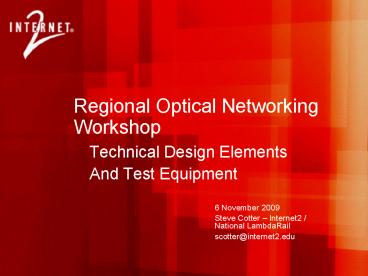Regional Optical Networking Workshop PowerPoint PPT Presentation
1 / 13
Title: Regional Optical Networking Workshop
1
Regional Optical Networking Workshop
- Technical Design Elements
- And Test Equipment
Steve Cotter Internet2 / National
LambdaRail scotter_at_internet2.edu
2
Technical Design Elements Terminology
- Decibels (dB) used for power gain or loss
- Decibels-milliwatt (dBm) used for output power
and receive sensitivity - Attenuation loss of power in dB/km
- Chromatic dispersion spreading of the light
pulse in ps/nmkm - Bit Error Rate (BER) typical acceptable rate is
10-12 - Optical Signal to Noise Ratio (OSNR) ratio of
optical signal power to noise power for the
receiver - ITU Grid Wavelength standard for the lasers in
DWDM systems
3
Technical Design Elements Optical Budget
- Optical budget Output power Input sensitivity
- Optical budget is affected by
- Fiber attenuation
- Splices
- Patch panels / connectors
- Optical components (filters, amplifiers, etc.)
- Bends in the fiber
- Contamination (dirt, oil, etc.)
4
Technical Design Elements Power Penalties
- Penalty Ranking
- Fiber loss (attenuation)
- Splices
- Connectors
- Dispersion Penalties
- Fiber Nonlinearities Penalties
- Component / Fiber Aging Penalties
- Transforms the signal
- from this
to this
High to Low
5
Technical Design ElementsPenalties
- Attenuation pulse amplitude reduction limits
how far - Chromatic Dispersion spreading of the pulse from
different colored light traveling at different
speeds within the fiber - Polarization Mode Dispersion spreading of the
light pulse from fast and slow axes having
different group velocities
6
Technical Design ElementsChromatic Dispersion
- Higher bit-rates and shorter pulses are affected
by chromatic dispersion more - Limits how fast and how far
- Combat CD by using DSF and NZDSF or dispersion
compensators
7
Technical Design ElementsDispersion Compensation
- How far can I go without dispersion compensation?
- Distance (Km) Specification of Transponder
(ps/nm) - Coef.of Dispersion of
Fiber (ps/nmkm) - A receiver with dispersion tolerance of 3400
ps/nm is sent across a standard SMF-28 fiber
which has a Coefficient of Dispersion of 17
ps/nmkm. - It will reach 200 Km at maximum bandwidth.
- (Note that lower speeds will travel farther.)
8
Technical Design ElementsPolarization Mode
Dispersion
- Caused by ovality of the core due to
- Manufacturing process
- Internal stress (cabling)
- External stress
- Only discovered in the 90s
- Most older fiber not
- characterized for PMD
- Weaker phenomenon than CD but of relevance at bit
rates of 10 Gb/s and greater
9
Technical Design ElementsNonlinear Effects
- Not a problem with lower power settings
- Nonlinear
- Four-wave mixing
- Self-phase modulation
- Cross-phase modulation
- Stimulated scattering
- Raman
- Brillouin
10
Technical Design ElementsFiber Types
- SMF (standard, 1310 nm optimized, G.652)
- Most widely deployed so far, introduced in 1986,
cheapest - Corning SMF-28
- Corning SMF-28e is considered extended band
fiber optimized for CWDM - DSF (Dispersion Shifted, G.653)
- Intended for single channel operation at 1550 nm
- Corning DSF
- NZDSF (Non-Zero Dispersion Shifted, G.655)
- SMF/LS (limited slope) fiber from Corning
- Later fiber types are engineered for WDM
operation in the 1550 nm region only - TrueWave, FreeLight, LEAF, E-LEAF, TeraLight
- These are the latest generation fibers developed
in mid 90s - For better performance with high capacity DWDM
systems - Optimized for DWDM in the C-band L-band
- MetroCor, WideLight are other types
- Low PMD ULH fibers are also out there
11
Technical Design ElementsFiber Table
- The primary difference in these fiber types is
their chromatic dispersion characteristics
12
Test EquipmentBuy or Rent
- Optical Time Domain Reflectometer
- Measure attenuation along span
- Can be used to troubleshoot fiber cuts
- Optical Spectrum Analyzer
- Display and measure the power levels of all the
lambdas on the fiber - Helps ensure waves are balanced
- Consider purchasing two
- Want one with at least 2 nm sensitivity
- Bit Test Set
- Perform packet loss test to determine your BER
- We require a 24 hour test before accepting
circuits - 1310nm / 1550nm Light Source
- Optical Power Meter
- Chromatic Dispersion test set
- SONET / GE / 10GE test sets
13
(No Transcript)

